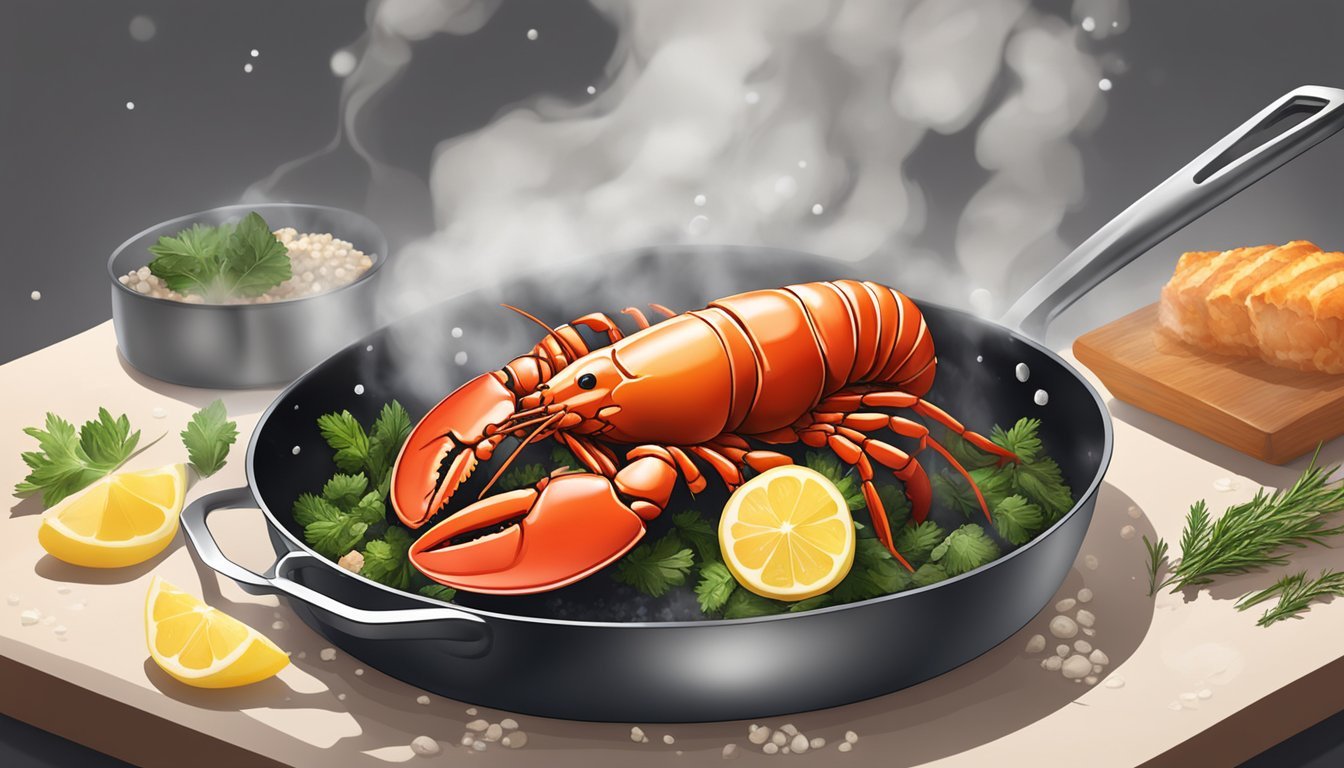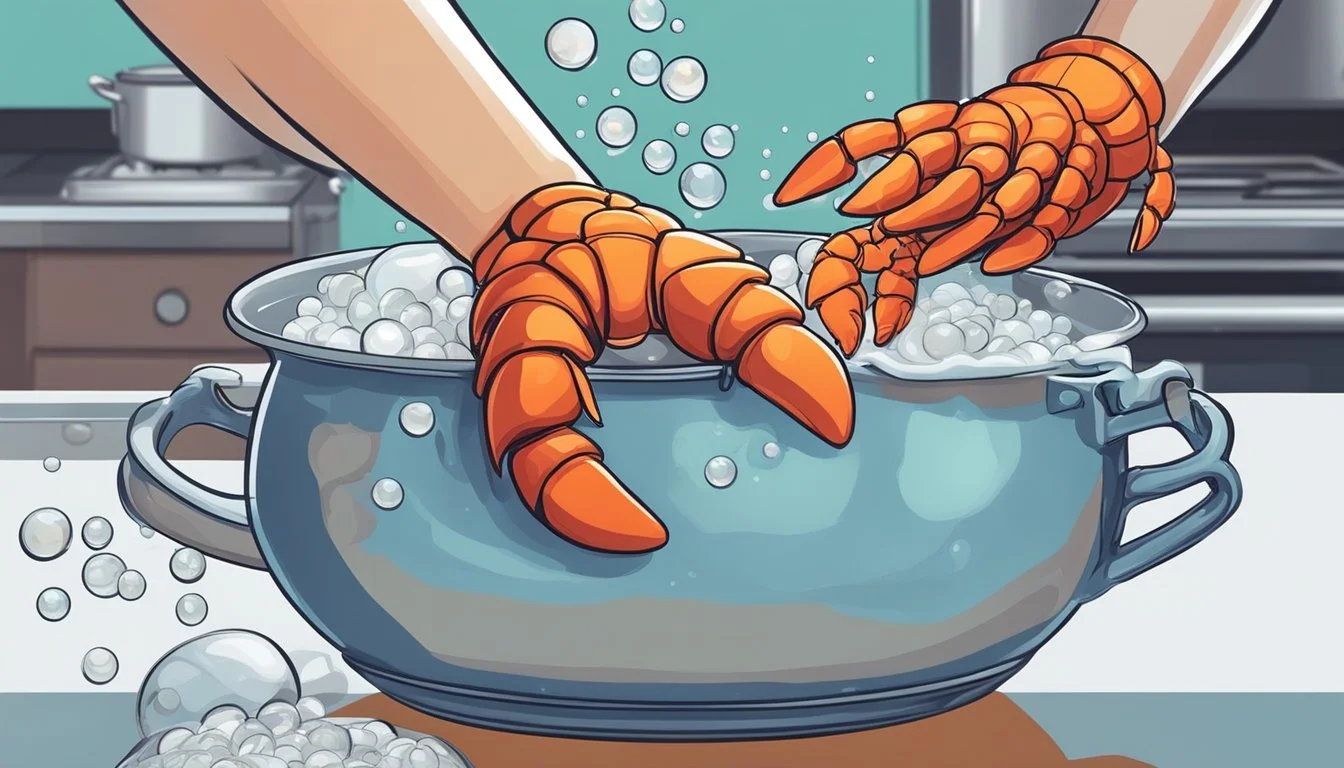Perfectly Tender Lobster Tails
From Oven to Plate in 30 Minutes
Lobster tails are a luxurious delicacy that can transform any meal into a gourmet experience. These succulent morsels of seafood are prized for their sweet, tender meat and are often associated with special occasions. Cooking lobster tails at home is surprisingly simple and can be done using various methods such as boiling, baking, broiling, steaming, or grilling.
While lobster is known for being expensive, preparing it at home can be more cost-effective than dining out. With the right techniques, anyone can achieve restaurant-quality results in their own kitchen. Lobster tails are versatile and can be seasoned with a range of flavors, from classic lemon and butter to more adventurous spice blends.
Whether you're planning a romantic dinner or simply treating yourself to something special, mastering the art of cooking lobster tails is a valuable culinary skill. By following some key tips and choosing the best cooking method for your preferences, you can create an impressive dish that rivals those served in high-end seafood restaurants.
Selecting Quality Lobster Tails
Choosing high-quality lobster tails is essential for a delicious seafood meal. The freshness and proper handling of lobster tails greatly impact their flavor and texture.
Fresh vs Frozen Lobster Tails
Fresh lobster tails offer superior taste and texture, but frozen tails are more readily available. Fresh tails have a shorter shelf life and require careful handling. They should be cooked within 1-2 days of purchase.
Frozen lobster tails can be stored for several months and are often more affordable. When properly frozen and thawed, they can still provide excellent flavor. Thaw frozen tails in the refrigerator for 24 hours before cooking.
Some chefs prefer frozen tails as they're flash-frozen at sea, preserving freshness. Both fresh and frozen can yield delicious results when handled correctly.
Identifying Fresh Lobster Tails
Fresh lobster tails have a translucent, grayish-green color. The meat should be firm and smell like the ocean - not fishy or ammonia-like. Avoid tails with black spots or discoloration on the meat.
Check for:
Firm, springy texture
No signs of freezer burn
Intact shell without cracks
If purchasing whole lobsters, look for active specimens. They should curl their tails when picked up. Tails should be proportionate to the body size.
For frozen tails, ensure packaging is intact with no signs of thawing and refreezing. Avoid packages with large ice crystals, which indicate improper storage.
Preparation Before Cooking
Proper preparation is crucial for delicious lobster tails. Thawing frozen tails correctly and cleaning them thoroughly ensure the best results. Careful cutting techniques enhance both presentation and flavor.
Thawing Frozen Lobster Tails
Thaw frozen lobster tails in the refrigerator for 8-10 hours or overnight. Place them in a sealed plastic bag to prevent water absorption. For quicker thawing, submerge the sealed tails in cold water for 30-60 minutes, changing the water every 15 minutes.
Never use hot water or a microwave to thaw lobster tails, as this can partially cook the meat and affect texture.
Cleaning and Cutting
Rinse thawed lobster tails under cold running water. Pat dry with paper towels. Using kitchen shears, cut along the top of the shell from the open end towards the tail tip, stopping at the base.
For butterflying, use a chef's knife to cut the meat down the center without slicing through the bottom shell. Gently separate the meat from the shell, keeping the base attached.
Remove the dark vein running along the tail's length if visible. This step improves both appearance and taste.
On a clean cutting board, carefully loosen the meat from the sides of the shell. Lift it slightly, allowing it to rest on top of the shell for an attractive presentation.
Cooking Methods for Lobster Tails
Lobster tails can be prepared using various cooking techniques, each offering unique flavors and textures. The key is to avoid overcooking while ensuring the meat is thoroughly cooked.
Boiling Lobster Tails
Boiling is a quick and simple method for cooking lobster tails. Fill a large pot with salted water and bring it to a rolling boil. Gently place the tails in the water.
Cook uncovered for about 1 minute per ounce of tail meat. For example, a 4-ounce tail would take approximately 4 minutes to cook.
The shells will turn bright red, and the meat will become opaque when done. Remove the tails with tongs and let them cool briefly before serving.
Steaming Lobster Tails
Steaming preserves the natural flavors of lobster meat. Add about 2 inches of water to a pot with a steaming basket. Bring the water to a boil.
Place the lobster tails in the basket, shell-side up. Cover and steam for 3-4 minutes per ounce of tail meat.
The shells will turn red, and the meat will be opaque when fully cooked. Carefully remove the tails from the steamer to avoid burns.
Grilling Lobster Tails
Grilling imparts a delicious smoky flavor to lobster tails. Preheat the grill to medium-high heat. Butterfly the tails by cutting through the top of the shell lengthwise, stopping at the base.
Brush the meat with melted butter and seasonings. Place the tails on the grill, meat-side up.
Grill for 5-7 minutes, then flip and cook for another 4-5 minutes. The meat should be opaque and register 135-140°F internally when done.
Baking Lobster Tails
Baking offers a hands-off approach to cooking lobster tails. Preheat the oven to 425°F. Place the tails on a baking sheet or in a baking dish.
Butterfly the tails and brush with melted butter and seasonings. Bake for 12-15 minutes, depending on the size of the tails.
The meat should be opaque and reach an internal temperature of 140°F. Avoid overbaking, as it can make the meat tough.
Broiling Lobster Tails
Broiling creates a delicious caramelized crust on lobster meat. Preheat the broiler. Butterfly the tails and place them on a baking sheet.
Brush the meat with melted butter and seasonings. Position the tails about 4-5 inches from the heat source.
Broil for 5-10 minutes, depending on size. The meat should be opaque and slightly browned on top. Watch closely to prevent burning.
Monitoring Cooking Times and Temperatures
Precise timing and temperature control are crucial for perfectly cooked lobster tails. Vigilant monitoring ensures tender, juicy meat without overcooking.
Checking for Doneness
Cooked lobster meat turns opaque and white. The shell changes from blue-green to bright red. Gently pull away the shell to check the meat's color. It should be firm to the touch but not rubbery.
Cook times vary by method and size. For boiling, allow 1-2 minutes per ounce. Bake 6-ounce tails at 425°F for 10-12 minutes. Broil 4-5 minutes per side.
Test for even cooking by gently separating the meat from the shell. If it releases easily, it's likely done.
Using a Thermometer
An instant-read thermometer provides the most accurate doneness check. Insert it into the thickest part of the tail meat.
The USDA recommends cooking lobster to 145°F for food safety. Many chefs prefer 135-140°F for juicier results.
Check temperature in multiple spots, especially for larger tails. Avoid touching the shell or broiling pan with the thermometer for an accurate reading.
If the temperature is too low, continue cooking in short increments. Recheck every 1-2 minutes to prevent overcooking and chewy meat.
Enhancing Flavor and Presentation
Elevating lobster tails goes beyond cooking techniques. Crafting flavorful accompaniments and thoughtful plating transforms the dish into a gourmet experience.
Creating Compound Butter
Compound butter enhances lobster's natural sweetness. Mix softened unsalted butter with finely minced garlic, chopped fresh parsley, lemon zest, and a pinch of salt. Form into a log, wrap in parchment paper, and chill until firm. Slice and place atop hot lobster tails just before serving.
For a zesty variation, incorporate lemon juice and cracked black pepper. Alternatively, blend in finely diced shallots and tarragon for a French-inspired twist.
Experiment with different herb combinations like dill, chives, or cilantro to create unique flavor profiles. A dollop of compound butter melts beautifully over the warm lobster meat, infusing it with rich, complementary tastes.
Selecting Accompaniments
Choose sides that complement lobster's delicate flavor without overpowering it. Lemon wedges are essential, providing a bright acidity that cuts through richness.
Steamed asparagus or green beans offer a crisp texture contrast. Roasted baby potatoes seasoned with olive oil, salt, and rosemary make an elegant starch option.
For a luxurious pairing, serve lobster tails alongside creamy risotto or buttery mashed potatoes. A light mixed green salad with a citrus vinaigrette balances the richness of the dish.
Garnish plates with fresh herbs like parsley or chives for a pop of color. A small ramekin of melted butter on the side allows diners to customize their flavor experience.
Finishing and Serving
Proper presentation and complementary pairings elevate lobster tails from a simple seafood dish to an elegant dining experience. Thoughtful plating and well-chosen accompaniments enhance the flavor and visual appeal of this luxurious meal.
Arranging the Serving Platter
Place cooked lobster tails on a large, clean serving platter. Garnish with lemon wedges and fresh herbs like parsley or dill for a pop of color. Arrange melted butter in small ramekins nearby for easy dipping.
For a classic lobster dinner presentation, surround the tails with drawn butter, lemon wedges, and seafood crackers. Include moist towelettes for messy fingers.
When serving lobster rolls, place them on a bed of lettuce leaves or in traditional split-top buns. Garnish with a sprinkle of paprika or Old Bay seasoning for added flavor and visual appeal.
Pairing with Sides and Wines
Choose light, complementary sides that won't overpower the delicate lobster flavor. Steamed vegetables like asparagus or green beans work well. A simple mixed green salad or coleslaw adds freshness.
Starchy sides like roasted potatoes, rice pilaf, or corn on the cob provide satisfying texture contrasts. For a complete seafood feast, consider pairing lobster tails with other shellfish like shrimp or crab legs.
Wine pairings enhance the dining experience. Opt for crisp white wines like Chardonnay, Sauvignon Blanc, or Pinot Grigio. For red wine enthusiasts, a light Pinot Noir can work nicely. Champagne or sparkling wine adds a touch of celebration to the meal.
Proper Storage and Reheating
Preserving lobster tail quality requires careful storage and reheating techniques. Proper methods maintain flavor and texture while preventing foodborne illness.
Storing Leftover Lobster
Refrigerate cooked lobster tails within 2 hours of preparation. Place them in airtight containers or wrap tightly in aluminum foil. Stored correctly, they'll keep for 3-4 days in the refrigerator.
For longer storage, freeze lobster tails. Wrap each tail individually in plastic wrap, then place in freezer bags. Remove as much air as possible before sealing. Frozen lobster tails can last up to 6 months.
Thaw frozen tails in the refrigerator overnight before reheating. Never thaw at room temperature, as this can promote bacterial growth.
Best Practices for Reheating
Steaming is the preferred method for reheating lobster tails. It preserves moisture and prevents overcooking. Use a steamer basket over boiling water for 5-7 minutes.
Oven reheating is another effective option. Preheat to 350°F (175°C). Wrap tails in foil with a splash of water or butter. Heat for 10-15 minutes until internal temperature reaches 165°F (74°C).
Avoid microwaving, as it can result in uneven heating and rubbery texture. If necessary, use 50% power in short bursts, checking frequently.
Never reheat lobster more than once. Discard any leftovers that have been at room temperature for over 2 hours to prevent foodborne illness.




